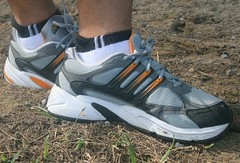
The following are the characteristics of a mammalian red blood cell:
- Shape: biconcave (provides large surface area for more absorption of oxygen).
- No nucleus (this enables the red blood cell to accommodate more haemoglobin so that more oxygen molecules can be transported and to make the red blood cell more flexible so that it can squeeze itself through the blood capillaries).
- Produced by the bone marrow as shown below.

- Lifespan: 3 to 4 months (when they are worn out, they are destroyed in the liver).
- Contains haemoglobin (a speial kind of protein containing iron): this pigment enables red blood cell to transport oxygen from the lungs to all cells in the body (mind you carbon monoxide combines readily with haemoglobin than oxygen).
- When haemoglobin is broken down in the liver, the iron is released and stored in the liver (hence liver is very rich source of iron). Bile pigments are also produced during the breakdown of haemoglobin (bile pigments are excreted into the colon and gives faeces its colour - brownish and sometimes greenish depending on the amount of bile pigments being excreted).
BLOOD APPEARS RED IN COLOUR BECAUSE OF THE RED BLOOD CELLS
